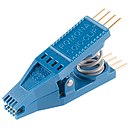 | |
| Developer(s) | flashrom team |
|---|---|
| Stable release | 1.5.1 [1] / 22 December 2024 |
| Repository | |
| Written in | C |
| Operating system | DragonFly BSD, DOS, FreeBSD, kFreeBSD, Linux, macOS, NetBSD, OpenBSD, Solaris, Windows (partial) |
| Available in | English |
| Type | Firmware utility |
| License | GNU General Public License |
| Website | www |
Flashrom is a software utility published under an open source license that can detect, read, verify, erase, or write EEPROMs using interfaces such as the Low Pin Count (LPC), FWH, parallel, and Serial Peripheral Interface (SPI). It can be used to flash firmware images such as BIOS or coreboot, or to backup existing firmware.

